Whereas we can sit here and assume that everyone in the known universe is familiar with the world’s most popular pet snake, there has to be people who would like to know more about the corn snakes. In case that person is you, then this is the best article for you to not only learn about these adorable snakes in relation to acquiring and caring for them.
Corn snakes are some of the most adorable starter snake pets. It is an adorable species of snake and when it reaches adult size, it becomes convenient for easy housing and handling. In general, they have a calm temperament, a wide genetic variety, and ease of captive propagation.
With this species of snakes, you can enjoy the best aspects of snake keeping and even an excellent prospect for successful reproduction. Since this is an attractive species other keepers will also be eager to acquire your surplus offspring.
It makes all the sense why this article is focused on corn snake for starter. Focusing on these pet snakes is important and we will inform you on all aspects relating to them to make it easy for you to make informed decisions especially if you are a beginner keeper.
Thanks https://pixabay.com/ for the awesome pictures of corn snakes in this article.
Contents
- What are the Different Types of Corn Snakes?
- What are the Common Types of Corn Snakes?
- What are the Other Less Common Types of Corn Snakes?
- Where are Corn Snakes From?
- Where Do Corn Snakes Live?
- What does a baby eat?
- What does an adult eat?
- How Often Do Corn Snakes Eat?
- How long do Corn Snakes Live?
- How fast do Corn Snakes Grow?
- How big do Corn Snakes Get?
- How often do corn snakes shed their skin?
- How Much are Corn Snakes?
- Do corn snakes have fangs?
What are the Different Types of Corn Snakes?
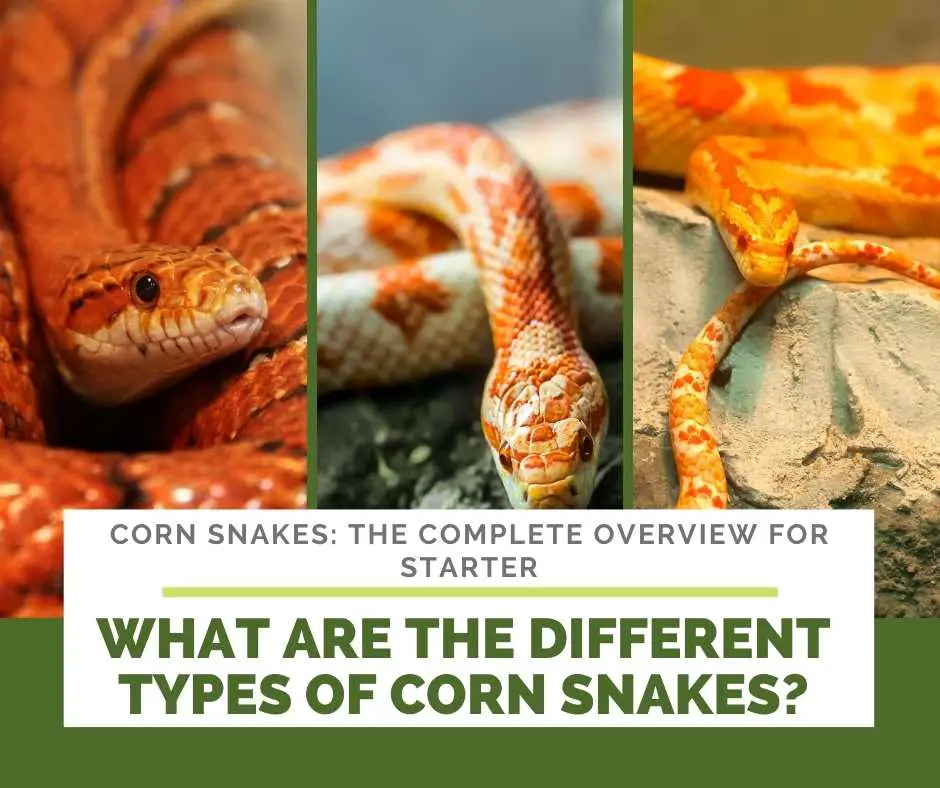
Whereas the corn snake is one species of snake, Pantherophis guttatus, over time people have bred them in order to create the different varieties present in the pet stores today. Corn snake for starters should revolve on understanding the different types available in the market for purchasing.
The list of the morphs is wide, but there are a select few common. They include Okeetee corn snake, the Albino corn snake, the Anerythristic corn snake, the Black corn snake, the Blood Red corn snake, the Candycane corn snake, and the Alabama corn snake. Whereas these are the most common morphs, persistent breeding results in new varieties regularly.
What are the Common Types of Corn Snakes?
Okeetee Corn Snakes

It is easily the most common and popular corn snake breeds, and overall for all snakes. They are known for their thick, black borders around the spots known as the saddle marks on their backs. The thick border gives the snake a distinctive appearance.
The general body colors are reddish brown, and sometimes tan with brown spots and white on the body. The stomach is mostly tan or off-white, and most of this type of corn snake has red saddle markings, while at times they can be reddish brown or orange.
People refer to this morph as the ideal looking version of the wild version. It was originally found in South Carolina and grow to 3-5 feet in length. They are hearty and thick. They can survive by eating a rat or a small sized mouse once every two weeks. Okeetee Hunt Club in South Carolina is the origin of their name.
Albino Corn Snake
This is another morph of corn snakes that is beautiful to look at. They are bred specially. They are also referred to as amelanistic corn snakes since they lack melanin. This breed is mainly light in color and almost white. They can also be pink, yellow, red or orange. They may also have a combination of these colors. No dark colors appear on the skins at all.
Whereas the albino corn snake is not plain white, there are other morphs including snow corn snake and blizzard corn snakes, which are brighter white colored and have less visible patterns. However, they are not as popular among the pet keepers due to their rarity and they are expensive.
They have bright red eyes, which is exotic and intimidating. In fact, if your pet albino corn snake has some red patterns on the back to match, it becomes even more beautiful.
Anerythristic Corn Snakes
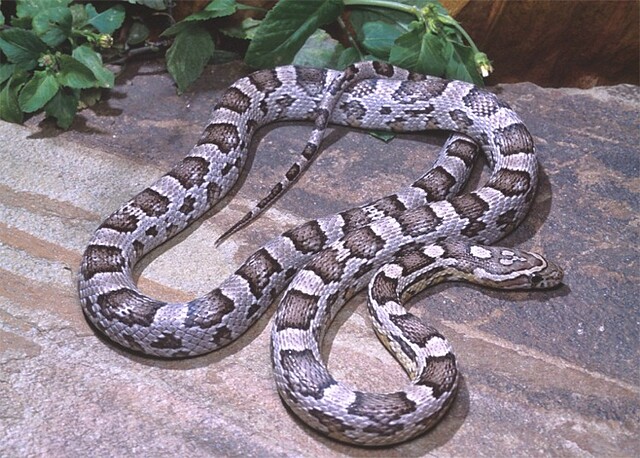
These types of corn snakes are popular because they camouflage. It is easy for them to blend into their natural environment. This morph lacks all the red pigment common with other corn snakes. As such, this means the snakes are mainly black, brown, white, and/or gray.
Although the morph is not one of the most exotic-looking varieties. It appears wild and appealing.
The colors create contrast easily and make the snake look sleek and dangerous, which is especially an added advantage since they are pretty much harmless snake. They may also have some yellow on their necks and stomachs.
Black Corn Snakes

These are specially bred anerythristic snakes and also lack the red pigment. They also lack any brown or tan pigments. They are mainly black with or grey saddle markings and borders. Their stomach is normally white and there are grey or white markings on their heads.
This morph has black eyes, and they are beautiful creatures, which add to their popularity as pets. Pricing is relatively low making them ideal snake for beginners.
Blood Red Corn Snakes

Some people consider this morph as the scariest among corn snakes. It is probably my favorite as it is cool and exotic looking. They have intense bold and intense red color.
Their breeding has now been done to an extent where they have little to no visible patterns on their backs. They appear sold red or red-orange. Nonetheless, some of them still have some patterns on their backs, but red is the main color.
They originate from Florida, and initially had patterns. Their young have patters, which disappear as they get into adulthood. This breed is mostly white on the stomach and has red eyes and black pupils.
Candy Cane Corn Snakes

This one is a popular breed due to the white and red skin that makes it look like a candy cane. It is also possible to have them with more striped-like patterns as opposed to the common saddle markings. They also miss the dark pigment in the skin similar to the albino corn snakes.
This is one of the more exotic and popular morphs among the corn snakes due to the patterns of red and white contrasts. As a specialty breed, it may be one of the more expensive corn snake types, but it is definitely worth it.
Alabama Corn Snakes

As the name truly suggests, this morph is mainly found in Alabama. It is a popular breed with these guys been known for their black and white checkered bellies. Their skin is brown or tan with dark, deep red saddle markings. The saddle markings have dark or dark brown borders. The sides of this snake are usually not patterned and they vary from brown or tan color.
Due to the coloring on the sides, the saddle markings may look more like stripes. It is a morph that looks dangerous, edgy and sleek, which adds to the popularity.
Cinder Corn Snakes

These guys are mainly gray or brown and their popularity is on the rise among the corn snake morphs. They look like they have been in ash or cinder and hence their name. Since their color is not like most other corn snakes, they can be considered exotic.
They have dull brown colored saddle markings. They lack red pigment from their skin. It is common for this snake to be slimmer compare to other morphs.
Palmetto Corn Snakes

For any snake or reptile lover, there is nothing that compared to the look of this morph. It has a white or an off-white body with red freckles on the back. It is one of the most beautiful reptiles on the planet. Sometimes the marks on the back are gray and you will be lucky if you find one with both colors.
I think this is the most diverse corn snake that is available. It lacks stripes or saddle markings. However, some of them have some orange marks on top of their heads. The first breeds of the morph were available in the market in 2011. As a result, they are rare and expensive.
The cost can be from $400 – $800, which can be a huge investment for a beginner keeper. Most people buying the snake are breeders. Nonetheless, that should not keep you away from investing in one of these neat and adorable pet.
What are the Other Less Common Types of Corn Snakes?
While this is a great place for a starter, the list is not exhaustive as new morphs get into the market. Other morphs may not be as popular in the market today, but there is definitely something to choose from for any new pet snake keeper. For instance, the blizzard snake is available, but also relatively expensive and rare.
Some of the less common types include hypomelanistic corns snake, topaz corn snake, tessera corn snake, scaleless corn snake, snopal stripe (glacial stripe) corn snake, pastel motley corn snake, sunspot corn snake, and Miami corn snake. The list is not exhaustive as new morphs are being bred.
Where are Corn Snakes From?
History and heritage of a pet is essential when it comes to the topic of corn snakes for starter.
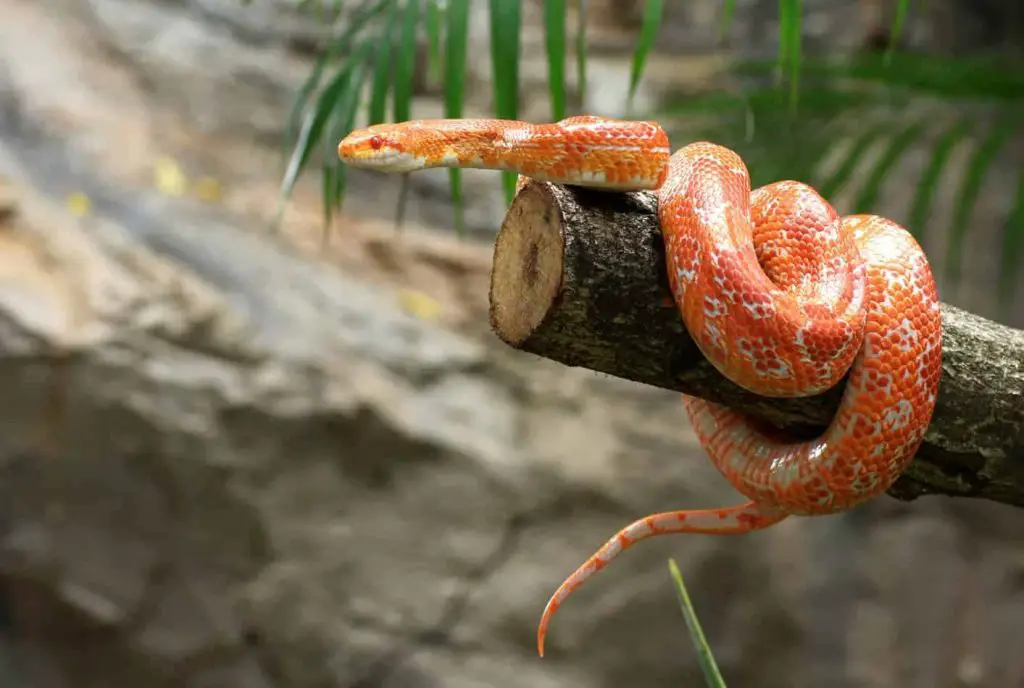
Corn snakes originate mainly from the southeastern areas of the United States.
The natural habitat where the snakes are found in wooded groves, rocky hillsides, meadowlands, woodlots, barns, and abandoned buildings. In general, they are found in forests, savanna or grassland.
Where are snakes from in the United States?
Corn snakes can be found in the eastern United States from south New Jersey south through Florida, west into Louisiana and parts of Kentucky. They are found in abundance in Florida and southeastern United States.
Where are Corn Snakes from Outside of the United States?
There are introduced populations recorded in several Caribbean islands including Bahamas, Grand Cayman, the Lesser Antilles, and the U.S. Virgin Islands. These are the main natural areas where they can be found in the wild outside the United States.
Where Do Corn Snakes Live?
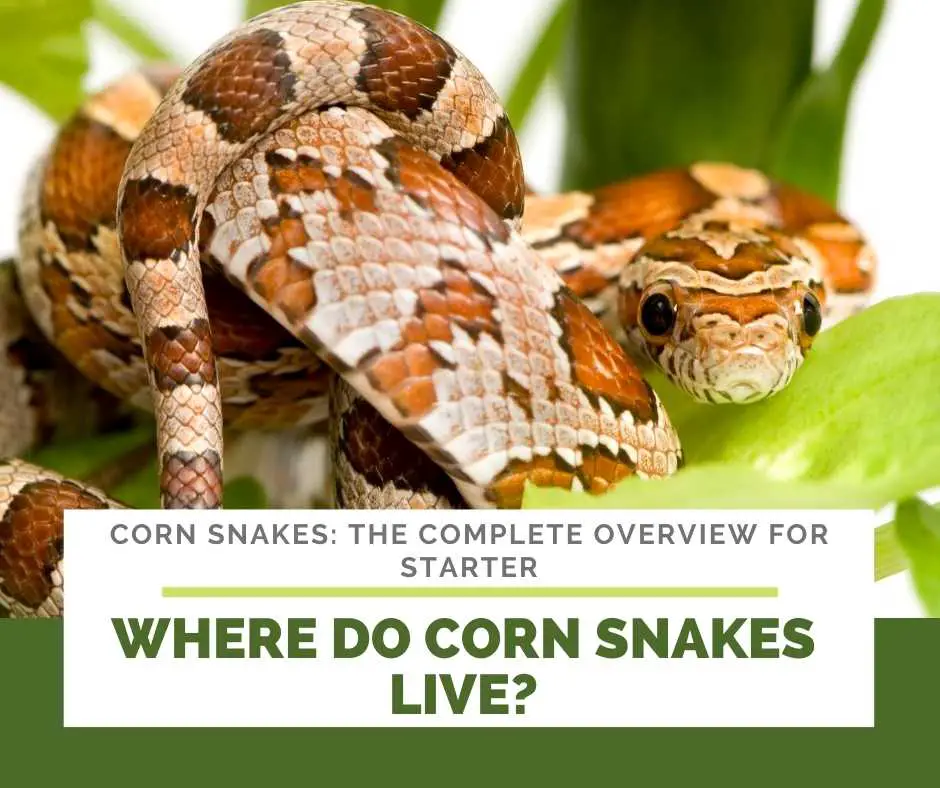
Corn snakes can be found both in the wild and in captivity. Not only can they be found as pets in the United States, but they are also present in other parts of the world. The snakes can live in natural habitat, as well as, as pets in captivity.
Where Do Corn Snakes Live in Natural Habitat?
Corn snakes live in a wide variety of habitats including natural and captivity. Natural habitats include pine and oak woodlands, but they may also be found in grasslands.
On the other hand, they are also associated with human habitation and as such, they are found houses, rubbish dumbs and railway lines. Overgrown fields and flat plains with borrows are common as habitats for corn snakes.
Where Do Corn Snakes Live in Captivity?
When in captivity or being kept as a pet, it is important for you to note that corn snakes struggle with cold and humidity. Therefore, consideration is important prior to looking for a vivarium for them. Ventilation is critical for them to ensure that heat and humidity are regulated to the ideal levels.
A solid cage for the corn snake is necessary. A 20-gallon long tank makes a good sized cage for a pet corn snake. A secure-fitting lid is necessary and it should be clamped since corn snakes tend to push with their noses. Provide hiding spots and a climbing branch in the cage as well.
When well cared for, corn snakes can live in any part of the world. As a keeper, you need to ensure that their temperature and habitat needs are met to enable them live comfortably. If there is a chance of extreme temperatures for the snakes, you should avoid exposure.
The temperature should be kept at 21 – 29 degree Celsius (70 – 85 degrees Fahrenheit). Focusing on corn snakes for starter, it is critical to understand these issues to enable you enjoy your pet.
What does a baby eat?
In general, corn snakes eat small animals including reptiles and mammals. For the baby corn snakes, they also eat this diet, but in significantly smaller portions. In addition, the frequency of meals varies in the young ones compared to adults.
These younglings eat lizards and tree frogs. They also eat newborn mice. It is ideal to offer young corn snakes live newborn mouse instead of previously frozen, but fully thawed. These young ones may not be used to the frozen, but fully thawed mice and they may be stressed by their new home.
However, this should not be a worry for you as a new keeper since it won’t take many times to train them on eating thawed mice. Training should be done by placing your young corn snake and a thawed mouse in an empty container with a few holes and closing the lid. It will concentrate on the food and encourage it to eat.
Baby corn snakes should be fed once every five to seven days. You should also place fresh water in a shallow.
But heavy reptile water bowl. The bowl should be cleaned every few days or sooner if it gets soiled.
Getting into this arena of raising corn snakes from younglings or becoming a breeder in the future is critical. It makes corn snakes for starter ideal reptilian pets to raise from younglings into adulthood.
What does an adult eat?
As highlighted so far, corn snakes primarily eat rodents, but they also eat birds and bats. Corn snakes are constrictors, which makes them ideal pets since they are non-venomous like a black snake.
It means that they use their oils to suffocate their food before eating. As such, even if feeding them in their cages, they tend to conduct themselves in the same manner.
Therefore, it is ideal to feed them by handing them the food holding the tail so that they can strike. Adult corn snakes can eat previously frozen, but fully thawed food. They have also been observed to swallow small preys alive.
What Do Adult Corn Snakes Eat?
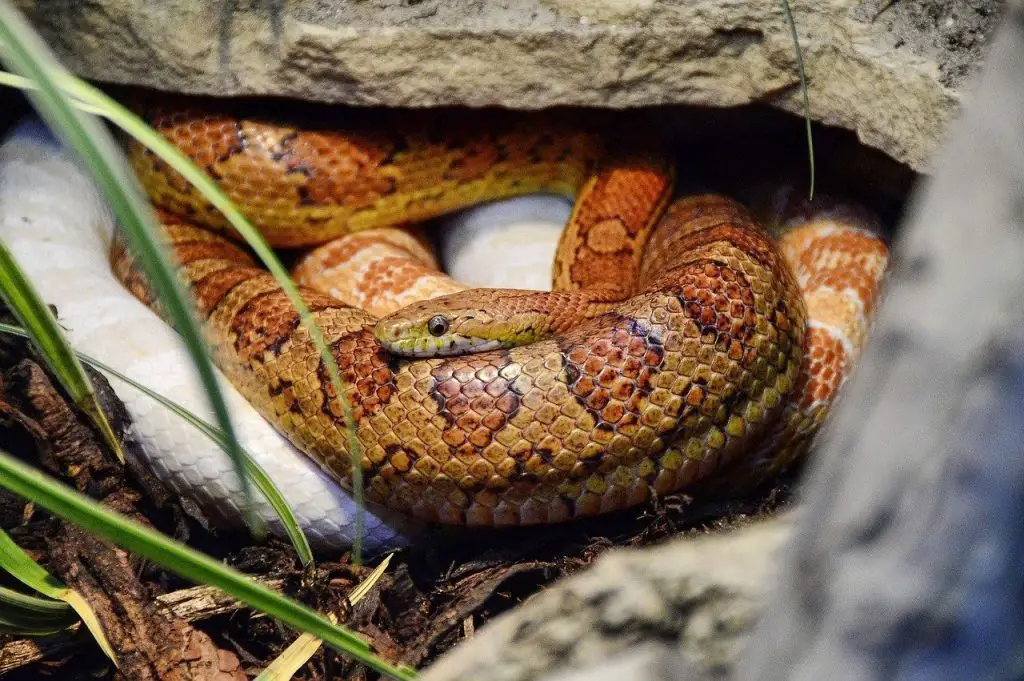
Please do not feed crickets to your favorite corn snake as it does not consider them food. Always ensure that clean water is always available in the cage. Note that corn snakes do not feed every day, but once every few days or so. You can also treat your favorite corn snake pet with a quail egg, but do not do so every day.
Rather, this should be a treat once every few weeks since in the wild quail eggs are not regularly available to the snakes hence it is not part of regular diet.
You do not need to vary the diet since they are happy with the same kind of meal. The ease in managing these pets makes corn snakes for starter not only interesting, but also appropriate for you as a beginner.
How Often Do Corn Snakes Eat?
As mentioned, corn snakes do not need to eat daily. Among the corn snake owners community, there exists a feeding plan guide. It gives an approximation of how as an owner you should feed your corn snake and when.
The guide is known as the Munson feeding plan. It is based on the weight of your snake, which makes it important to ensure that you keep tabs on its weight.
The plan is per below:
| Snake Size | Amount of Food | No. of Days |
| 4-15g | 1 Pinkie (0.5-3g) | 4-5 days |
| 16-23g | Small Fuzzy (3-6g) | 5-6 days |
| 24-30g | Fuzzy (7-9g) | 6-7 days |
| 31-50g | Fluff/Hoppers (7-12g) | 6-7 days |
| 51-90g | Small Adult / Weaned (13-18g) | 7 days |
| 170g+ | Large (19-25g) | 7+ days |
| 400g+ | Extra Large (30g+) | 10 days |
It is ideal to calculate using grams as for small measurements they are more accurate than pounds and ounces. The amount of feeding needed is little compared to other common household pets, such as, cats and dogs.
Further advantages into why corn snakes for starters make it easy for you as the owner, and their being introductory pet into the world of reptiles.
How long do Corn Snakes Live?
The life span of a corn snake is dependent on the care given. If properly cared for, corn snakes can live at least to its latter teens or into its 20s. Often, your pet corn snake will remain productive until 10 to 12 years and sometimes longer.
How long do it live in the wild?
Interestingly, pet keepers like you have come around to assist pet corn snakes live longer lives than their cousins in the wild. In general their lives in the wild only extend to about 6-8 years. Lack of protection from predators and health issues lead to their early death in the wild.
Furthermore, the diet in the wild is dependent on the effort of the snake and it may go for weeks without catching any food. As such, the diet is not ample, which reduces the snake’s life expectancy.
How long do they live in captivity?
Unfortunately, most corn snakes in captivity do not live as long as we would wish. Why? The main reason is poor husbandry. Since most people buy snakes from pet stores, such stores may not have adequate knowledge on how to take care of such an animal. Therefore, the pet may have some problems as you buy them.
Not to worry though. If well cared for, your favorite pet snake will live a long and happy life, which you will enjoy together. As with most pet keepers, you want to have your pet for as long as possible. Corn snakes for starter are ideal in this sense as the keeper will have them around for a long time.
How fast do Corn Snakes Grow?
As mentioned, your favorite corn snake will start its life very small at just a few inches long.
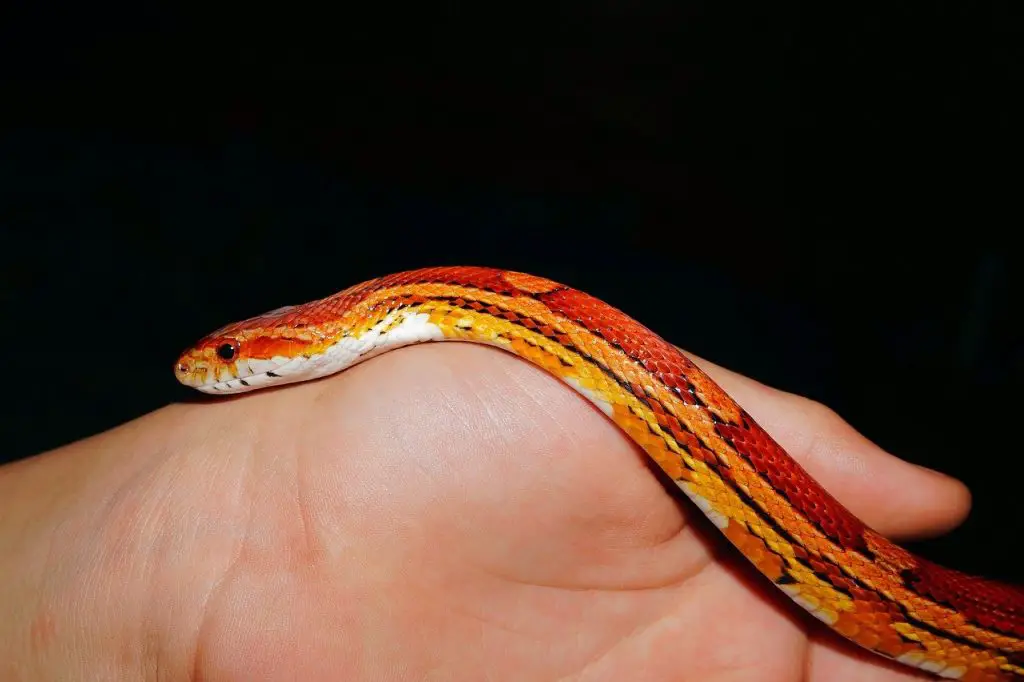
However, with proper care and feeding, corn snake will soon grow into a large adult. Focusing on the period it takes from a youngling to an adult, corn snakes make a real transformation within a short span.
How fast do they grow from hatchling to adult length?
From a baby corn snake to an adult-sized pet, it takes about two years. Afterward, the length of the snake does not change materially.
Therefore, the measure of how fast these popular pets grow is approximately two years.
How fast do they grow with proper care?
Proper feeding is essential to ensure that they reach their full length within the time.
However, if your pet does not get to five foot within two years, do not panic.
Other factors including genetics play a role and your cute pet may only grow up to anything between 2.5 and 5 feet when fully mature. It is a consideration that you need to know.
Younglings are normally vulnerable to handle for a keeper. Corn snakes for starter make these pets even better compared to others because young ones mature fast. It also means that there is an increased number of adults in the market and at reasonable prices.
How big do Corn Snakes Get?
Corn snakes are some of the least imposing snakes due to their size. Understanding how big they get and how long it takes them is important for a beginner keeper. Ordinarily, corn snakes can measure anywhere between 2.5 to 5 feet in length.
Typically, males tend to be a bit larger than females. After hatching, they tend to be less than a foot in length, and it takes approximately two years for them to reach full size. Feeding and caring impacts heavily on how they grow.
An average corn snake will rarely grow to more than 5 feet long. However, it will most likely between the 2.5 and 5 feet mark. Comparing those bred in the wild versus those in captive, the wild corn snakes tend to be larger. However, the size is not significant enough to have significant impact on the visuals.
If you keep your favorite corn snake in a tank that is too small, it is most likely going to remain small since it lacks enough space to move around.
A large sized snake can be intimidating for a beginner keeper. Corn snakes for starter make very standard sized pets for ease of handling and knowledge gathering on how to handle them. Corn snakes make it easy for you as a new keeper to understand how to deal with reptiles.
How often do corn snakes shed their skin?
As your corn snake grows, you should expect it to shed its skin. It is a normal occurrence, and it happens every few weeks when they are small. As they grow bigger, the period between sheds increases too. An adult corn snake may only shed once every few months. Corn snakes for starter provide an opportunity for keepers to enjoy witnessing their pet grow and shed.
How often Do Young Corn Snakes Shed their Skin?
A hatchling corn snake will shed their first skin within 7 days. As they grow older, the shedding happens every few weeks. Some people wonder whether there is a time of the year when corn snakes shed, like some of a “shedding season”. No, there is nothing like that. Snakes shed when they need to, and it is as a result of having outgrown their skin.
Temperature in a vivarium is expected to be relatively constant throughout the year, which means that there is no “real” seasonal changes in your pet’s world.
However, in case your cage is not temperature controlled, and there is massive influence of external temperature, the snake will tend to shed more often in summer. This is explained by the fact that they are more active during the warm weather.
How often they shed their skin?
Shedding is a time that every keeper is interested in experiencing. As a new keeper signs to look out for when the snake is about to shed include hiding more than regular, and the snake goes through the “blue phase”.
“Blue phase” is the period just prior to the snake’s shedding. It is referred to as such because your snake’s eyes turn cloudy or blue. The phase lasts for three or four days, and the snake may become dull too. Once the phase is done the snake clears up and goes back to normal, but it has not shed yet. Shedding occurs a few days later.
The process of shedding might take six and nine days, and this includes the blue phase and hiding stages. The shed skin should come off as one piece and if it comes in patches, there is a problem with the humidity in the cage.
How Much are Corn Snakes?
The cost of a corn snake varies due to the different elements involved.
There are one time costs and others that one has to incur regularly. However, overall these costs are relatively low for a first-time keeper. Corn snakes for the starter are reasonably priced making them an easy place to start for pet keepers.
How much are they for one time costs?
As appealing and adorable as these snakes are, it is astonishing to note that they are readily available in pet stores.
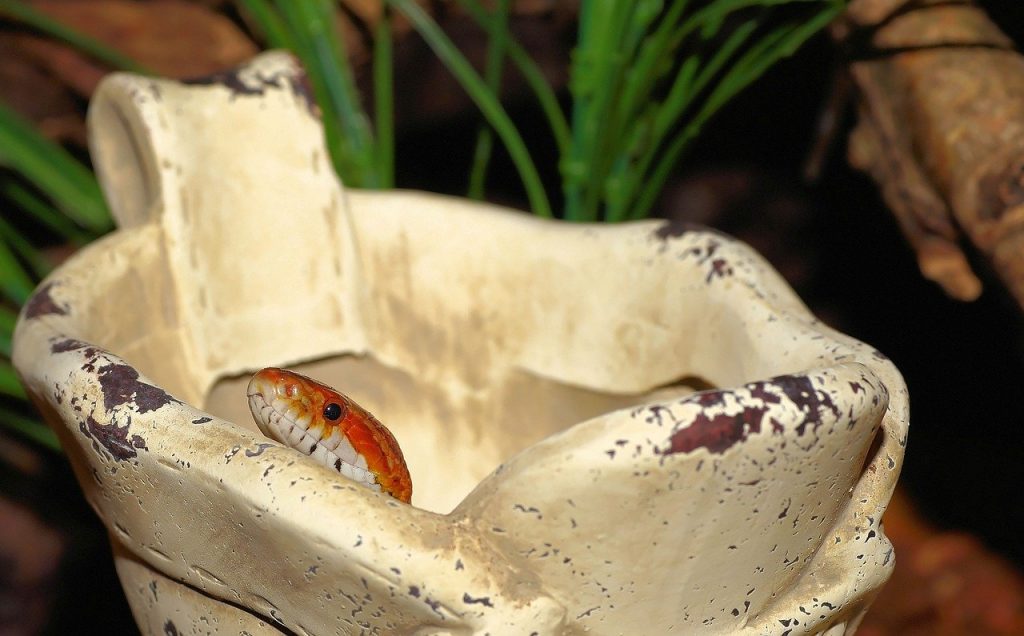
Since there are a variety of morphs available, the most common ones are inexpensive.
The price of a corn snake ranges from $30 to $800 depending on the morph and length.
Some exclusive and exotic morphs may price more than $1,000. Common morphs including albino, okeetee, snow, black, and lavender range from $30 to $75.
However, scaleless versions of these morphs are more expensive as they may be more than $1,000.
However, you should note that if you are in the United States, there are laws and regulations around keeping of these snakes.
In Georgia, they are in the list of nonvenomous snakes that you cannot kill, capture or harass. In Jersey, you can only keep certain morphs of the snake including candy cane, blizzard, lavender, butter, creamsicle, snow, and albino.
Once you have bought your snake, you must ensure that it has a comfortable shelter. Costs associated with the shelter include a glass vivarium that can cost $120 for a decent sized one or more if you want larger cage.
Artificial hiding places for the snake can be bought for $20, but you simply use an ordinary rock or wood. A branch in the cage also adds to the comfort of the snake, and it stimulates natural behavior. It can be bought for $10 or you can use one from your locality for free.
Bedding or substrate for your corn snakes is also necessary. You must ensure that the bedding is toxic scent and oil free as they are hazardous to the pet snake. A bag of good quality substrate can range from $10 to $20, and it can last from four to six months.
Installations for heating and lighting or climate regulation can cost $50, and this should include a heat pad, humidity gauge, heat pad and thermometer.
How much are they as regular costs
Once the pet is in place and housed comfortably, some costs starting adding up for the maintenance. Feeding is essential. They feed once in every 7-10 days on average and for $0.3-$1.25, you can order rodents online in bulk.
Some medical costs may also be necessary even though corn snakes are some of the healthiest species and do not need regular vet visits. However, in case you need to make a visit, initial checkup costs from $40-$100. Since they are exotic, it is necessary to check with your local vets to ensure the services are available.
Occasional baths are vital for your corn snake, and this should be done and it is not pricey.
A good bath bowl can be acquired for less than $13. In addition, you need to conduct habitat maintenance and a terrarium cleaner can be acquired for $13. These are the main costs to look out for, but in general, corn snakes are some of the least expensive and easy to maintain snakes. It makes corn snakes for starter enjoyable pets for both the keeper and the animal.
Do corn snakes have fangs?
Corn snakes don’t have fangs, they have teeth instead. And corn snakes also not a venomous species. So, that why its the best choice for beginner.
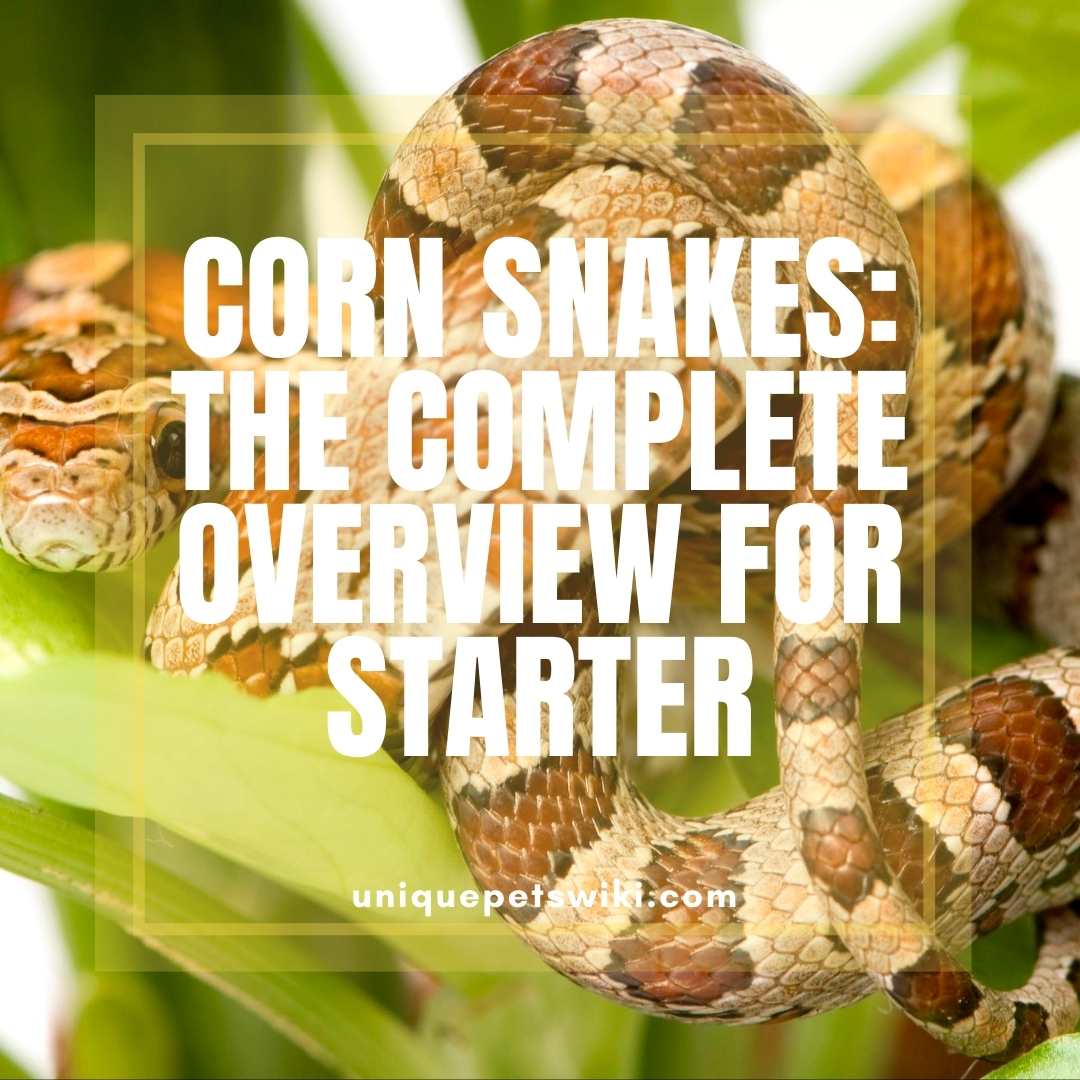
Invite Bloggers and Webmasters to Fill out Paid Surveys
I’m Andrews from Biglep.
We are working with Inboxdollars to provide bloggers another opportunity to earn cash.
After joining Inboxdollars, you will be able to get rewards by sharing your opinions online.
Paid surveys are ready to be sent to you: https://www.biglep.com/paidsurvey
Regards,
Aracely P. Andrews
Unsubscribe: https://www.biglep.com/unsubscribe